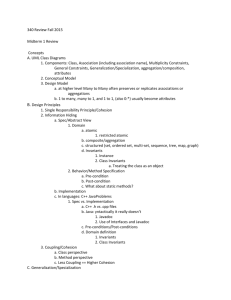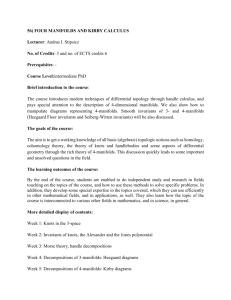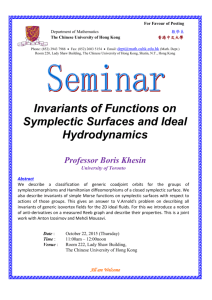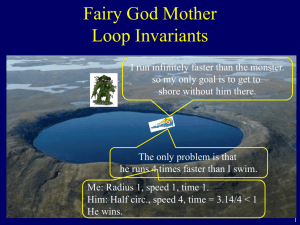11 VECTOR INVARIANTS OF Syl (GL(n, F )) AND THEIR HILBERT
advertisement
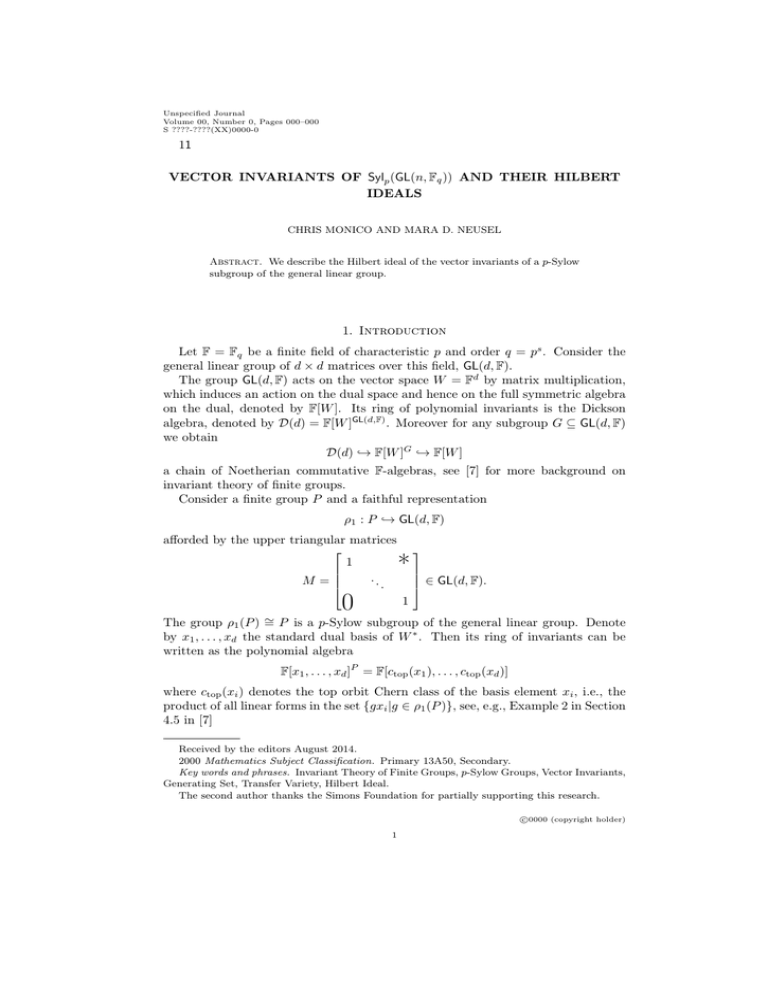
Unspecified Journal
Volume 00, Number 0, Pages 000–000
S ????-????(XX)0000-0
11
VECTOR INVARIANTS OF Sylp (GL(n, Fq )) AND THEIR HILBERT
IDEALS
CHRIS MONICO AND MARA D. NEUSEL
Abstract. We describe the Hilbert ideal of the vector invariants of a p-Sylow
subgroup of the general linear group.
1. Introduction
Let F = Fq be a finite field of characteristic p and order q = ps . Consider the
general linear group of d × d matrices over this field, GL(d, F).
The group GL(d, F) acts on the vector space W = Fd by matrix multiplication,
which induces an action on the dual space and hence on the full symmetric algebra
on the dual, denoted by F[W ]. Its ring of polynomial invariants is the Dickson
algebra, denoted by D(d) = F[W ]GL(d,F) . Moreover for any subgroup G ⊆ GL(d, F)
we obtain
D(d) ,→ F[W ]G ,→ F[W ]
a chain of Noetherian commutative F-algebras, see [7] for more background on
invariant theory of finite groups.
Consider a finite group P and a faithful representation
ρ1 : P ,→ GL(d, F)
afforded by the upper triangular matrices
1
..
M =
.
0
*
∈ GL(d, F).
1
The group ρ1 (P ) ∼
= P is a p-Sylow subgroup of the general linear group. Denote
by x1 , . . . , xd the standard dual basis of W ∗ . Then its ring of invariants can be
written as the polynomial algebra
F[x1 , . . . , xd ]P = F[ctop (x1 ), . . . , ctop (xd )]
where ctop (xi ) denotes the top orbit Chern class of the basis element xi , i.e., the
product of all linear forms in the set {gxi |g ∈ ρ1 (P )}, see, e.g., Example 2 in Section
4.5 in [7]
Received by the editors August 2014.
2000 Mathematics Subject Classification. Primary 13A50, Secondary.
Key words and phrases. Invariant Theory of Finite Groups, p-Sylow Groups, Vector Invariants,
Generating Set, Transfer Variety, Hilbert Ideal.
The second author thanks the Simons Foundation for partially supporting this research.
c
0000
(copyright holder)
1
2
CHRIS MONICO AND MARA D. NEUSEL
In this article we consider the n-fold vector invariants of P , i.e., we embed the
group P into GL(dn, F)
ρn : P ,→ GL(dn, F)
afforded by the block diagonal matrices
block(M, . . . , M ) =
| {z }
..
.
0
n times
0
M
M
⊕n
for all M ∈ ρ1 (P ). Denote by V = W
the corresponding dn-dimensional vector
space. We denote the standard dual basis of V ∗ by x11 , . . . , x1d , x21 , . . . x2d , . . . , xnd .
Recall that the Hilbert ideal of the ring of invariants F[V ]P is defined as the ideal
in the ambient ring of polynomials generated by all invariants of positive degree
H(ρn (P )) = (F[V ]P )F[V ].
In this paper we prove the following result:
Theorem 1.1. The Hilbert ideal H(ρn (P )) is generated by the top orbit Chern
classes of the basis elements xji , j = 1, . . . , n and i = 1, . . . , d.
Indeed, in the case of d = 2, this result follows from the description of the ring
of invariants:
Theorem 1.2. The ring of invariants F[V ]P is generated by
ctop (xj1 )
j = 1, . . . , n,
and the elements in the ideal I = (x12 , . . . , xn2 )F[V ] ∩ F[V ]P .
Ever since Weyl’s First Main Theorem of Invariant Theory vector invariants have
been extensively studied. We mention some of the (for our paper) most relevant
results: In [4] Grosshans studied Weyl’s result over algebraically closed fields of
finite characteristic. Richman computed in [9] the generating set of the ring of
invariants for the case p = q = 2 and d = 2. Campbell and Hughes proved in
[2] Richman’s conjecture on the generating set for the case p = q and d = 2. In
[3] Campbell, Shank and Wehlau produced a SAGBI basis for the case p = q and
d = 2. In Sezer’s and Ünlü’s paper [8] we find a description of a reduced Gröbner
basis of the Hilbert ideal for p = q = 2 and d = 2.
In the next section we choose a term order and prove some technical preliminary
results. In Section 3 we prove Theorem 1.2 and deduce Theorem 1.1 for the case
d = 2. This serves as an induction start. The induction is completed in Section
4 proving Theorem 1.1 in general. In Section 5 we explain the significance of the
ideal I of Theorem 1.2: It is the radical of the image of the transfer.
2. Choosing a Good Term Order
We denote the variables as x11 , . . . , x1d , x21 , . . . , x2d , . . . , xn1 , . . . , xnd and order
them as follows
x11 > x21 > · · · > xn1 > x12 > · · · > xn2 > · · · > x1d > · · · > xnd .
This induces a lexicographic term order on the elements of F[V ]. We denote by
LT (−) the leading term of −. The following results motivate this choice of order.
VECTOR INVARIANTS OF p-GROUPS
3
Lemma 2.1. Let m ∈ F[x11 , . . . , xnd ] be a monomial. Then
LT (gm) = m
∀g ∈ P .
Moreover, gm = m + h for some h ∈ (x12 , . . . , xn2 , . . . , x1d , . . . , xnd )F[V ].
αnd
11
Proof. Let m = xα
11 · · · xnd . Let ρn (g) = block(M, . . . , M ) where
| {z }
n times
1
0
M =
...
0
a12
..
.
..
.
···
..
.
..
.
···
0
a1d
..
.
∈ ρ1 (P )
ad−1,d
1
be an arbitrary element of ρn (P ). Then
Y
(xji + ai,i+1 xj,i+1 + · · · + aid xjd )αji .
gm =
j,i
Expanding this expression gives the desired result.
αn1
11 α21
Lemma 2.2. If f ∈ F[V ]P has a term xα
11 x21 · · · xn1 , then αj1 is divisible by
d−1
q
for all j = 1, . . . , n.
Proof. We prove this by induction on n. If n = 1 we have an explicit description of
the ring of invariants (see introduction) and we note that the top orbit Chern class
d−1
ctop (x11 ) = xq11
+ other terms
11
is the only generator with a term xα
11 .
Next, let n > 1. We consider the term
αn1
11 α21
m = xα
11 x21 · · · xn1 .
In case that there is a j0 such that αj0 1 = 0 we obtain our desired statement by
induction hypothesis. So assume that αj1 6= 0 for all j = 1, . . . , n. We sort the
αn1
nd
invariant f by monomials xn1
· · · xα
nd and obtain
X
αnd
n1
f=
fI xα
n1 · · · xnd
I
where the sum runs over d-tuples I = (αn1 , . . . , αnd ). Note that
fI = fI (x11 , . . . , x1d , . . . , xn−1,1 , . . . , xn−1,d ).
αn1
n1
Our monomial m appears in fI0 xα
n1 for I0 = (αn1 , 0, . . . , 0). By Lemma 2.1 xn1
cannot be a nontrivial translate of any monomial. Therefore, fI0 has to be an invariant. In particular we can assume by induction that α11 , . . . , αn−1,1 are divisible
by q d−1 .
Switching the roles of n and, say, n − 1 in this argument allows us to conclude
that all αj1 , j = 1, . . . , n are divisible by q d−1 .
4
CHRIS MONICO AND MARA D. NEUSEL
3. The case of 2 × 2-matrices
In this section we prove Theorem 1.1 for the case d = 2, which serves as an
induction start as it will become apparent in Section 4. We note that the result
of this section was proven in [1] for the cases q = 2, 4, n = 2, 3, in addition to the
papers mentioned in the introduction.
Consider the p-Sylow subgroup of GL(2, F) given as follows:
ρ1 : P ,→ GL(2, F)
where
1 a
P ∼
|a ∈ F} ⊆ GL(2, F).
= ρ1 (P ) = {M ∈ GL(2, F)|M =
0 1
It is an elementary abelian p-group of rank s. Its ring of invariants is given by
F[x, y]P = F[xq − xy q−1 , y]
where we chose the standard dual basis x, y for V ∗ . Note that this is a polynomial
algebra generated by the top orbit Chern classes of the basis elements:
Y
ctop (x) =
gx = xq − xy q−1 ctop (y) = y.
g∈P
Next consider the 2-fold vector invariants of P , i.e., we look at the faithful representation of P
ρ2 : P ,→ GL(4, F)
afforded by the block diagonal matrices
1 a
0 1
0
0
1
0
a
1
where a ∈ F. Its ring of invariants is given by
F[x1 , y1 , x2 , y2 ]P = F[ctop (x1 ), y1 , ctop (x2 ), y2 , Q12 ]/(r)
where
Q12 = x1 y2 − x2 y1
and
r = Qq12 − ctop (x1 )y2q + ctop (x2 )y1q − Q12 y1q−1 y2q−1
see [6].1 Next consider the n-fold vector invariants of P :
1 a
0 1
..
P ∼
= ρn (P ) = {
|a ∈ F} ⊆ GL(2n, F).
.
1 a
0 1
0
0
We denote the standard dual basis as x1 , y1 , x2 , y2 , . . . , xn , yn and note that by
choice of our order we have
x1 > x2 > · · · > xn > y1 > · · · > yn .
1This article treats only the case where q = p. However, the proof works in the general case.
VECTOR INVARIANTS OF p-GROUPS
5
Theorem 3.1. The ring of invariants F[V ]P is generated by
ctop (xj ), j = 1, . . . n
and the elements in the ideal I = (y1 , . . . , yn )F[V ] ∩ F[V ]P .
Proof. Let A be the F algebra generated by ctop (xj ) , j = 1, . . . , n and the elements
in the ideal (y1 , . . . , yn )F[V ] ∩ F[V ]P . By construction A is a subalgebra of the
invariants F[V ]P .
Any invariant f such that each of its terms is divisible by one of the yj ’s is in I.
αn
1
Next, let f ∈ F[V ]P be an invariant not in I. Then f contains a term xα
1 · · · xn .
By Lemma 2.2 we have that all the αj ’s are divisible by q. Set αj = qkj , then
f − ctop (x1 )k1 · · · ctop (xn )kn
αn
1
is an invariant such that the monomial xα
1 · · · xn is replaced by an element of the
ideal (y1 , . . . , yn )F[V ], because
n
n
Y
Y
qk
(xqj − xj yjq−1 )kj =
(xj j ) + h
ctop (x1 )k1 · · · ctop (xn )kn =
j=1
j=1
where h ∈ (y1 , . . . , yn )F[V ]. Successively we obtain an invariant in (y1 , . . . , yn )F[V ]
and hence in I.
Corollary 3.2. The Hilbert ideal is generated by the top orbit Chern classes of the
basis elements x1 , . . . , xn , y1 , . . . , yn .
Proof. The Hilbert ideal is generated by all invariants of positive degree, i.e., it is
generated by the orbit Chern classes ctop (x1 ), . . . , ctop (xn ) and the elements in the
ideal (y1 , . . . , yn )F[V ] ∩ F[V ]G . Since the yj ’s are top orbit Chern classes (and in
particular invariant) we are done.
4. The General Case d > 2
We start by proving a refinement of Lemma 2.2 for the general case.
Lemma 4.1. Let f ∈ F[V ]P be an invariant with a term
αnd
11
m = xα
11 · · · xnd .
Then there exists a pair j0 , i0 such that αj0 i0 ≥ q d−i0 .
Proof. We proceed by induction on d.
Let d = 2. If xj0 2 divides m for some j0 = 1, . . . , n we are done. Otherwise,
αn1
11
m = xα
11 · · · xn1
and our result follows from Lemma 2.2. Thus let d > 2.
If
αn1
11 α21
m = xα
11 x21 · · · xn1
then we know by Lemma 2.2 that all the αj1 ’s are divisible by q d−1 as desired.
So consider monomials
αnd
11
m = xα
11 · · · xnd
such that there exists an exponent αj1 i1 6= 0 for i1 ∈ {2, . . . , d} and some j1 .
The group ρn (P ) contains subgroups Pr consisting of block diagonal matrices
block(M, . . . , M )
| {z }
n times
6
CHRIS MONICO AND MARA D. NEUSEL
with
1
M =
a1,2
1
a2,3
..
.
0
..
.
0
1
0
..
.
···
a1,d−1
···
a2,d−1
..
.
0
ad−1,d
···
..
.
1
i.e., the rth column and the rth row are zero except at the r, r spot where there
is a 1. We note that for all r = 1, . . . d the group Pr is isomorphic to the p-Sylow
subgroup of GL(d − 1, F). The inclusion of groups induces an embedding of the
invariants of P into those of Pr .
Let us consider the group P1 . Then f as well as x11 , x21 , . . . , xn1 are invariant
under P1 . Sorting by monomials in the xj1 ’s we obtain
X
αn1
11
f=
fI xα
11 · · · xn1
I
where the sum runs over n-tuples I = (α11 , . . . , αn1 ). Note that the polynomials fI
are P1 -invariant. Thus by induction hypothesis we can assume that in each of the
monomials appearing in a fI there exists a j0 ∈ {1, . . . , n} and an i0 ∈ {2, . . . d}
such that
αj0 i0 ≥ q d−i0
unless fI ∈ F.
We are ready to prove Theorem 1.1 in general.
Theorem 4.2. The Hilbert ideal is generated by the top orbit Chern classes of the
basis elements xij , i = 1, . . . , n and j = 1, . . . , d.
Proof. By construction
J = (ctop (xji ), ∀i, j) ⊆ H(ρn (P )).
To show the reverse inclusion, let F ∈ H(ρn (P )). Then
F =
u
X
Hr fr
r=1
for some nontrivial P -invariants fr and some Hr ∈ F[V ]. We proceed by induction
on term order. The smallest monomial in any degree δ is xδnd which is invariant as
well as in our proposed ideal J. Let
β11 +···+βnd
LT (F ) = xβ1111 · · · xβndnd > xnd
.
Without loss of generality we can assume that the leading term of F appears in
H1 f 1 :
αnd
11
xβ1111 · · · xβndnd = γh1 xα
11 · · · xnd
αnd
11
for some γ ∈ F× , and some terms h1 ∈ H1 and xα
11 · · · xnd in f1 . By Lemma 4.1
there exist j0 i0 such that
βj0 i0 ≥ αj0 i0 ≥ q d−i0 .
VECTOR INVARIANTS OF p-GROUPS
7
Thus
β
F − ctop (xj0 i0 )xj0ji00i0
−q d−i0
β
Y
xjiji < F .
ji6=j0 i0
Since the top orbit Chern classes are in the Hilbert ideal, we find by induction on
term order that the LHS is in J. Furthermore, the top orbit Chern classes are in
J, and therefore F ∈ J.
Observe that this result shows the following:
• The maximal degree of a generator of the Hilbert ideal is q d−1 which is far
less that the order of P .
• The Hilbert ideal does not characterize the group P as any group between
ρn (P ) and ρ(×n P ) has the same orbit Chern classes of the basis elements
and hence the same Hilbert ideal, where the representation
ρ : ×n P ,→ GL(dn, F)
is afforded by the matrices
block(I, . . . , I, M, I, . . . , I )
|
{z
}
n
where I ∈ GL(d, F) is the identity matrix, and M ∈ ρ1 (P ) appears in block
j for j = 1, . . . n. We will show in [5] that this phenomenon (and indeed
a more general statement) remains valid for large classes of groups and
representations.
5. The Transfer Variety of P
Recall that the transfer is given by
TrP : F[V ] −→ F[V ]P , f 7→
X
gf .
g∈P
It is an F[V ]P -module map and as such its image is an ideal in F[V ]P . We denote
by ∂g the twisted differential given by
∂g = 1 − g : V ∗ −→ V ∗ ,
for g ∈ P . We denote
Ig = (Im(∂g )) ⊆ F[V ].
By work of M. Feshbach, see, e.g., Theorem 6.4.7 in [7], we know that
\
Rad(ImTrP ) =
(Ig ∩ F[V ]P ) ⊆ F[V ]P .
g,|g|=p
Furthermore, the height of the image of the transfer is
height(ImTrP ) = dimF (V ) − max{dimF V g | |g| = p}.
Apparently, an element g ∈ ρn (P ) of order p whose fixed point set has maximal
dimension is given by
g0 = block(M, . . . , M ),
| {z }
n times
where M is an identity matrix with an additional 1 in the 1, d spot. Thus the height
of the image of the transfer is dn − (d − 1)n = n.
8
CHRIS MONICO AND MARA D. NEUSEL
Furthermore, note that
Im(∂g0 ) = spanF {x1d , . . . , xnd }
Thus
Ig0 = (x1d , . . . , xnd ) ⊆ F[V ]
is a prime ideal of height n. By the Krull relations it follows that Ig0 ∩ F[V ]P is a
minimal isolated prime ideal of ImTrP .
More generally we claim the following.
Proposition 5.1. The radical of the image of the transfer of P is given by
\
Rad(ImTrP ) = (la,1 , . . . , la,n ) ∩ F[V ]P
a
where a = (a2 , . . . , ad ) ∈ Fd−1 \ {0} and la,j = a2 xj2 + · · · + an xjn .
Proof. We note that any element ga = block(M, . . . , M ) where a = (a2 , . . . , ad ) ∈
| {z }
n times
Fd−1 \ {0} and
1
M =
a2
..
.
a3
···
ad
0
..
.
···
..
.
..
.
0
..
.
0
1
has order p. The ideal Iga associated to this element is one of the ideals mentioned
in the statement:
Iga = (la,1 , . . . , la,n ).
Finally, let g = block(M, . . . , M ) be an arbitrary element of order p and set
| {z }
n times
1
M =
a12
..
.
···
..
.
..
.
a1d
..
.
ad−1,d
1
Then Ig is the ideal in F[V ] generated by the linear forms
a12 xj2 + · · · + a1d xjd , . . . , ad−1,d xjd
∀j = 1, . . . , n.
However, Ig ⊃ Iga for a = (a12 , . . . , a1d ).
Observe that for the case d = 2 we obtain
Rad(ImTrP ) = (x12 , . . . , xn2 ) ∩ F[V ]P
as the ideals Ig are equal for all g ∈ P of order p, and hence the radical of the image
of the transfer is prime of height n.
VECTOR INVARIANTS OF p-GROUPS
9
References
1. A. Adcock, Vector Invariants of Elementary Abelian 2-Groups in Characteristic 2, Undergraduate Research, Texas Tech University 2008/2009.
2. H.E.A. Campbell and I. P. Hughes, Vector Invariants of U2 (Fp ): A Proof of a Conjecture of
Richman, Advances in Math. 126 (1997), 1-20.
3. H.E.A. Campbell, R. J. Shank and D. L. Wehlau, Vector Invariants for the two-dimensional
Modular Representation of a Cyclic Group of Prime Order, Advances in Math. 225 (2010),
1069-1094.
4. F. Grosshans, Vector Invariants in Arbitrary Characteristic, Transformation Groups 12
(2007), 499-514.
5. Chris Monico and Mara D. Neusel, Vector Invariants and Hilbert Ideals, in preparation.
6. Mara D. Neusel, Invariants of some Abelian p-Groups in Characteristic p, Proceedings of the
AMS 125 (1997), 1921-1931.
7. Mara D. Neusel and Larry Smith, Invariant Theory of Finite Groups, Mathematical Surveys
and Monographs Volume 94, AMS, Providence RI 2002.
8. Müfit Sezer and Özgün Ünlü, Hilbert Ideals of Vector Invariants of S2 and S3 , J. Lie Theory
22 (2012), 1181-1196.
9. D. R. Richman, On Vector Invariants over Finite Fields, Advances in Math. 81 (1990), 30-65.
Department of Mathematics and Statistics, MS 1042, Texas Tech University, Lubbock, Texas 79409
E-mail address: C.Monico@ttu.edu, Mara.D.Neusel@ttu.edu


